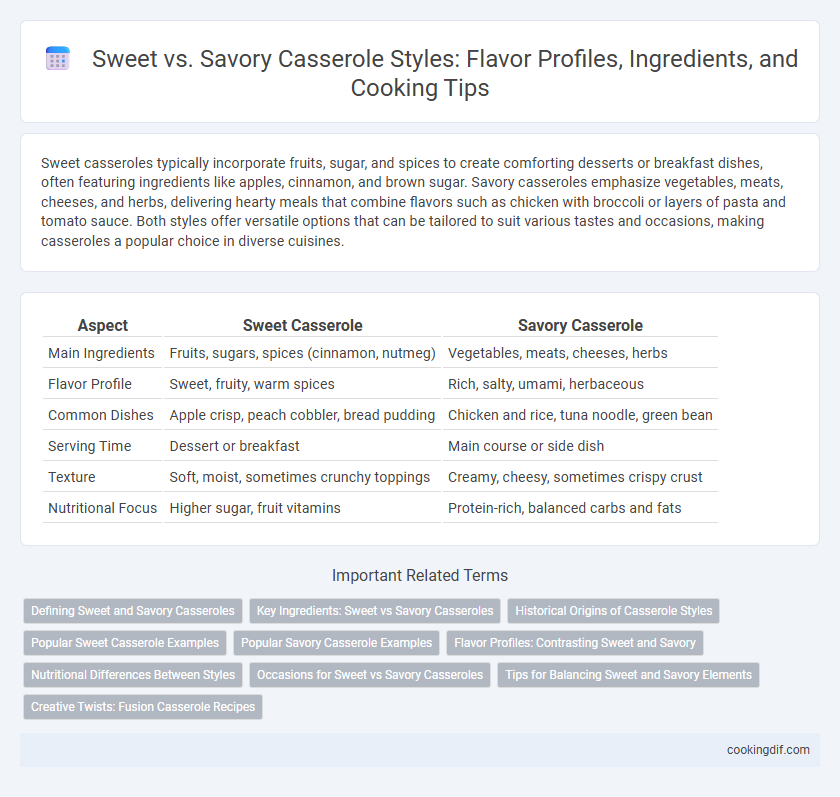Sweet casseroles typically incorporate fruits, sugar, and spices to create comforting desserts or breakfast dishes, often featuring ingredients like apples, cinnamon, and brown sugar. Savory casseroles emphasize vegetables, meats, cheeses, and herbs, delivering hearty meals that combine flavors such as chicken with broccoli or layers of pasta and tomato sauce. Both styles offer versatile options that can be tailored to suit various tastes and occasions, making casseroles a popular choice in diverse cuisines.
Table of Comparison
| Aspect | Sweet Casserole | Savory Casserole |
|---|---|---|
| Main Ingredients | Fruits, sugars, spices (cinnamon, nutmeg) | Vegetables, meats, cheeses, herbs |
| Flavor Profile | Sweet, fruity, warm spices | Rich, salty, umami, herbaceous |
| Common Dishes | Apple crisp, peach cobbler, bread pudding | Chicken and rice, tuna noodle, green bean |
| Serving Time | Dessert or breakfast | Main course or side dish |
| Texture | Soft, moist, sometimes crunchy toppings | Creamy, cheesy, sometimes crispy crust |
| Nutritional Focus | Higher sugar, fruit vitamins | Protein-rich, balanced carbs and fats |
Defining Sweet and Savory Casseroles
Sweet casseroles feature ingredients like fruits, sugar, and spices, creating a dessert-like or breakfast dish with a balance of sweetness and texture. Savory casseroles incorporate vegetables, meats, cheeses, and herbs, offering rich, hearty flavors suitable for main courses. Defining sweet and savory casseroles hinges on their primary flavor profiles and ingredient choices, which determine their role in a meal.
Key Ingredients: Sweet vs Savory Casseroles
Sweet casseroles often feature key ingredients such as fruits like apples, berries, or peaches, combined with sugars, cinnamon, and nutmeg to enhance their rich, dessert-like flavors. Savory casseroles typically incorporate proteins such as chicken, beef, or beans, along with vegetables like onions, mushrooms, and bell peppers, seasoned with herbs, garlic, and cheese for a hearty, umami taste. The choice between sweet and savory casseroles depends largely on the balance of these core ingredients, which define the dish's overall flavor profile and appeal.
Historical Origins of Casserole Styles
Sweet casserole styles have roots in early European casseroles where fruits, nuts, and sugars were baked with bread or grain bases, reflecting historical dessert traditions. Savory casseroles originated in medieval times as practical one-dish meals combining meats, vegetables, and starches in ovens or hearths, designed for family sustenance. These divergent approaches highlight distinct cultural and historical preferences in casserole preparation across regions.
Popular Sweet Casserole Examples
Sweet casseroles often feature fruits, sugars, and spices as key ingredients, creating a dessert-like dish with comforting textures. Popular sweet casserole examples include sweet potato casserole topped with marshmallows, bread pudding with cinnamon and raisins, and fruit cobblers baked with crumbly streusel. These dishes highlight the versatility of casseroles, balancing sweetness with rich, baked layers that appeal to a variety of palates.
Popular Savory Casserole Examples
Popular savory casserole examples include classic dishes like tuna noodle casserole, chicken and rice casserole, and green bean casserole, which combine protein, vegetables, and creamy sauces for a hearty meal. These casseroles often feature cheese, breadcrumbs, or cream-based soups to enhance flavor and texture. Savory casseroles are commonly served as comfort food during family gatherings and holiday dinners due to their rich, satisfying taste.
Flavor Profiles: Contrasting Sweet and Savory
Sweet casseroles often feature fruits like apples, berries, or sweet potatoes combined with cinnamon, nutmeg, and brown sugar to create warm, comforting flavors. Savory casseroles highlight ingredients such as cheese, meats, vegetables, and herbs like thyme or rosemary, offering rich, umami notes with a satisfying depth. The contrast between sweet and savory casseroles lies in their primary flavor profiles, where sweetness balances acidity and spice, while savory emphasizes saltiness, herbs, and hearty textures.
Nutritional Differences Between Styles
Sweet casseroles often contain higher sugar content, contributing to increased calorie and carbohydrate levels, while savory casseroles tend to offer more protein and fiber from ingredients like meats, vegetables, and legumes. The use of cream, cheese, and butter in savory casseroles can elevate fat and sodium content, contrasting with the typically lighter, fruit-based components of sweet casseroles. Nutritional differences highlight that choosing between sweet and savory casserole styles significantly impacts macronutrient profiles and overall dietary balance.
Occasions for Sweet vs Savory Casseroles
Sweet casseroles often appear at breakfast or brunch gatherings, featuring fruits, sugars, and spices that complement morning menus and festive celebrations. Savory casseroles are staples for family dinners and holiday feasts, combining meats, vegetables, cheeses, and sauces to provide hearty and comforting meals. Both styles cater to distinct occasions, with sweet casseroles enhancing casual or celebratory mornings and savory casseroles serving as substantial entrees for communal dining events.
Tips for Balancing Sweet and Savory Elements
Balancing sweet and savory elements in casseroles requires careful selection of ingredients to complement rather than overpower each other; incorporating ingredients like sweet potatoes with smoked bacon or adding a touch of honey to a cheesy spinach base enhances harmony. Use spices such as cinnamon or nutmeg sparingly to introduce warmth without clashing with savory components like onions or garlic. Control sweetness by balancing sugary additions with acidic elements like lemon juice or vinegar to maintain depth and avoid a cloying taste.
Creative Twists: Fusion Casserole Recipes
Sweet and savory casserole styles blend diverse flavors and textures, offering endless creative twists through fusion recipes that combine global culinary traditions. Incorporating ingredients such as spicy kimchi with creamy cheese or tropical fruits like pineapple with hearty meats redefines classic casseroles into innovative dishes. These fusion casseroles enhance traditional comfort food appeal, delivering dynamic taste experiences that satisfy eclectic palates.
Sweet vs savory casserole styles Infographic

 cookingdif.com
cookingdif.com